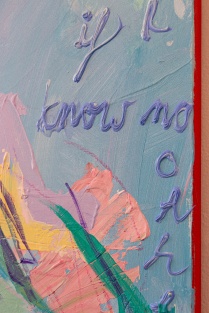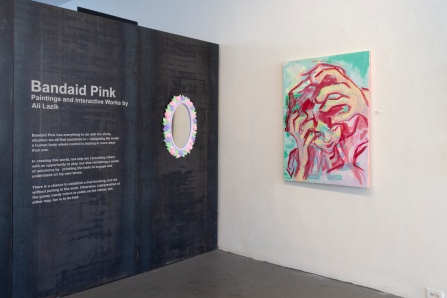Published June 18, 2024
Review of "Bandaid Pink"
Lydia Kegler (UB MFA, 2024), writes about "Bandaid Pink", the MFA thesis exhibition of Ali Lazik.
A palette of baby pink, lime green, cherry red, and a multitude of pastels overwhelms the eye upon entering Bandaid Pink at El Museo Gallery. Alphabet blocks ranging from the size of a hand to the size of a person are stacked on top of one another throughout the center of the room. The paintings on the walls depict body parts overlapping symbols and writing. The gestural brushstroke and non-naturalistic colors chosen by the artist, Ali Lazik, recall the Fauvist portraiture of the early 1900s. Body parts such as a foot rubbing against an ankle, enlarged hands, or the side view of a hip, are painted with flowing lines of blues, greens and pinks. On one wall of the gallery three rows of square canvases have what initially reads as an alphabet painted on them, one letter-like symbol per canvas. Upon looking closer, it becomes clear that the multi-colored painted symbols are their own markings invented by the artist. Underneath each symbol the background color contains a letter to translate each symbol into the Latin alphabet. Swirls, upside down tear drops, and markings resembling lightning compose the wall of encoded symbols. Lazik’s paintings and interactive works generate a coded language as a way of limiting the viewer’s understanding based on how much work they are willing to put into decoding.
Messages of desire and control over the body come through in the writing painted over and alongside body parts. A painting of hands spanning a few feet wide, one reaching outward, and the other relaxed underneath it, is overlaid with a combination of symbols and English writing. Across the top of the piece from left to right it reads: “I think you want”. From right to left reads: “don’t want you to touch me”. The lines meet in the middle, convoluting what is wanted and not. Bandaid Pink considers the lack of control that we have over our bodies. Notions of control come through in the portrayal of bodies in different shapes and gestures, and in the coded language that only allows certain kinds of understanding. Bandaid Pink is on view at El Museo from April 5th to May 11th, 2024. The exhibition is a thesis of Ali Lazik’s Master of Fine Arts at the University at Buffalo.
Photos by Ligia Sato, from the installation of "Bandaid Pink" at El Museo






About El Museo
Location
91 Allen Street, Buffalo, NY 14202
Mission
El Museo is a 501(c)3 nonprofit, visual arts organization dedicated to the exhibition of contemporary work by diverse artists and cultures.
Vision
El Museo provides programming and supports Western New York in cultivating a future where our communities are stronger because of the presentation and support of diverse artists and cultures.
History (abbreviated, from: http://www.elmuseobuffalo.org/about/)
In the 1970s, following the civil rights movement and a renewed emphasis on diversity politics and multiculturalism, cultural organizations proliferated working to represent minority groups and recognize their contributions to our common heritage. It was in this spirit that a group of young Latino artists primarily associated with the University at Buffalo formed the Latino Artists Collective in 1977 to promote Latino/a, Latin American, and Caribbean fine art in the region.
Without a permanent home, the collective became known for street corner drama, poetry, and literary readings. Meanwhile, visual artists in the group started a program called Gallery Without Walls, staging temporary art exhibitions in various locations on the West Side of Buffalo. In 1981, this program formalized to become El Museo Francisco Oller y Diego Rivera, honoring two of the most esteemed Puerto Rican and Mexican artists, respectively. Since then, we have expanded our mission to include all underserved groups including people of African, Latino/a, Asian, Arab, and Native American descent, women artists, and our region’s growing population of immigrants and refugees. In 1997 we moved into our current space on Allen Street and have since presented numerous exhibitions and public programs promoting diversity and inclusion, dialogue, and excellence in the arts and humanities.